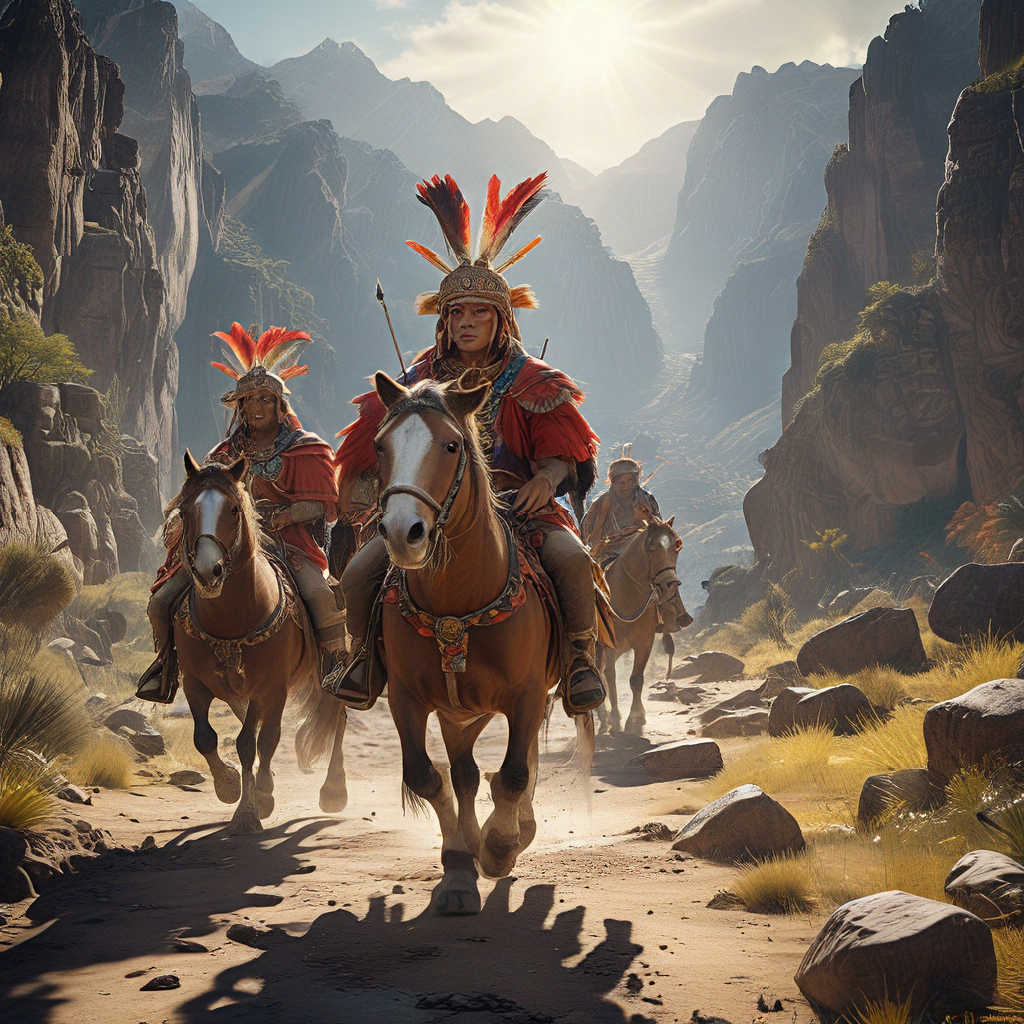The Myth of the Incan Chasquis: A Tale of Speed and Sacrifice
The Incan Empire, a vast and powerful civilization that dominated the Andes region of South America, is known for its intricate social structure, impressive architecture, and remarkable advancements in agriculture. One of the most intriguing aspects of Incan culture is the legend of the Chasquis, a network of runners who served as messengers, relaying information across the empire with astonishing speed. Over time, the Chasquis have become shrouded in myth, their efficiency and endurance often exaggerated in stories and tales.
The Chasqui: A Figure of Legend
The Chasqui, a term meaning "runner" in Quechua, the language of the Inca, is a figure of legend and folklore. They were portrayed as tireless messengers, capable of covering vast distances in short periods. They were said to run day and night, relying on a network of relay stations strategically placed throughout the Incan Empire. The chasqui system, or at least the idea of an incredibly fast messaging system, captured the imagination of explorers and historians, becoming a symbol of the Incan Empire's strength and organization.
The “Lightning-Fast” Delivery System: A Mythical Reality?
The myth of the Chasquis often depicts them as superhuman athletes, capable of running hundreds of miles in a single day. This image is frequently portrayed in historical accounts and popular culture, painting a picture of a "lightning-fast" delivery system that allowed the Incan emperor to stay informed about the vast empire. While the concept of a running messenger system is accurate, the speed and efficiency attributed to the Chasquis are often exaggerated.
Historical Evidence of the Chasqui System
Historical evidence suggests that the Chasquis did play a vital role in the Incan Empire, but their capabilities were perhaps less extraordinary than myth suggests. Documentation from the Spanish conquest of the Inca, as well as archaeological evidence, confirms the existence of a relay system. However, these sources paint a more nuanced picture than the legendary image. The Chasquis were likely not elite athletes but rather ordinary individuals, selected for their stamina and fitness. They were organized into groups and assigned specific routes.
The Role of the Chasqui in Incan Society
The Chasquis played a crucial role in the Incan Empire's administrative and military functions. They were responsible for delivering messages, official documents, and even goods. The information they carried included news of events, military movements, and administrative directives. As a result, the Chasquis facilitated communication and information flow throughout the vast empire, enabling the Incan emperor to maintain control and order.
The Limitations of the Chasqui System
While the Chasquis were undoubtedly essential to the Incan Empire, the speed and efficiency attributed to them in popular accounts are often exaggerated. The reality of the system was likely more complex and less glamorous than the legendary stories suggest. For one, the Inca Empire was vast and mountainous, with challenging terrain and extreme weather conditions. The Chasquis faced significant obstacles, including treacherous mountain passes, dense forests, and unpredictable weather.
The actual speed of the Chasquis is difficult to determine accurately. The distances covered were vast, but the routes were not always direct. Additionally, the Chasquis were not running constantly. They had to stop at relay stations for rest, food, and to exchange messages. These factors suggest that the messages were not delivered with the blazing speed often depicted.
The Myth of the Chasqui: An Interpretation of Imperial Power and Control
The myth of the Chasqui, as a symbol of incredible speed and efficiency, allows us to understand how the Inca themselves viewed their empire and the power of their emperor. The idea of the Chasquis carrying messages with lightning speed reinforces the idea of an effective and well-organized state. Their mythical ability to overcome any obstacle reflects the Incan emperor's control over the vast and diverse empire. It speaks to the power of the Inca to stay connected, informed, and in control, even across vast distances.
The Chasqui in Modern Culture and Popular Imagination
The Chasquis have continued to capture the imagination of people worldwide. They are featured in novels, films, and television shows, often portrayed as skilled runners with supernatural speed and endurance. These stories perpetuate the myth of the Chasquis, reinforcing the image of a highly efficient and tightly controlled Incan Empire. The Chasqui, as a powerful symbol, has become a part of popular culture, often used to represent speed, communication, and efficiency.
The Chasqui as Symbol: Speed, Efficiency, and Imperial Legitimacy
The Chasqui system, despite its limitations, played a significant role in reinforcing the Incan emperor's power and control. The Chasquis, seen as a symbol of speed and efficiency, served to legitimize the emperor's authority and demonstrate the strength and organization of the Incan Empire. They were a tangible display of the emperor's reach and the power of the state to connect with all corners of the empire.
Rediscovering the Truth: Challenging the Myths of the Incan Chasquis
The legend of the Chasquis is a fascinating example of how myths and legends can shape our understanding of history. While the Chasquis were important messengers, their abilities were likely more human and less extraordinary than the myths portray. Examining the historical evidence and challenging the popular myths allows us to gain a more accurate and nuanced understanding of the Incan Empire. By separating fact from fiction, we can better appreciate the true role of the Chasquis in the history of the Inca, shedding light on the complexities of this remarkable civilization.
FAQ
What exactly did the Chasquis carry in their messages?
The Chasquis carried messages relating to administrative matters, military movements, news of events, and even goods.
Did the Chasquis have specific routes or were they assigned randomly?
The Chasquis were assigned specific routes and had to learn their territory well.
What were the relay stations like?
The relay stations were strategically placed throughout the empire, likely located at strategically important points along the roads.
Why is the myth of the Chasqui so popular?
The myth of the Chasqui is popular because it reinforces the idea of a strong and well-organized Incan Empire. It makes for a compelling story and speaks to the amazing abilities of the Inca people.
Is there any modern-day equivalent to the Chasqui system?
While there is no exact modern equivalent, the Chasqui system shares similarities with systems like the Pony Express in the United States, which used riders to rapidly deliver mail across long distances.



